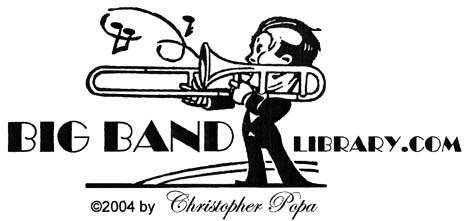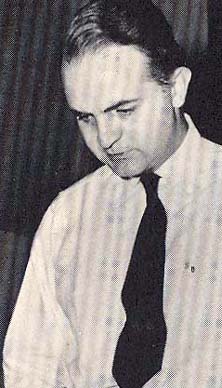
to Count Basie), Jumpin' Salty, and Minor De Luxe.
vital stats:
given name Joseph Francis Burke
birth Mar. 22, 1914, Scranton, PA
death May 31, 1980, Santa Monica, CA
education University of Detroit, Detroit, MI; B.A., English, Duke University, Durham, NC, 1937
wife Dorothy Gillis
children Tom and Jerry (twins); Peter; Nancy; Michael
memberships ASCAP, 1942-
hobbies boating; fishing; collecting historical autographs
physical description 6'1", 200 lbs. [ 1950s ]
"We didn't have any hits," Burke later remarked, "just good records."
After Donahue returned as leader, Burke went on to find fame in 1941-43 with Charlie Spivak's band, as the composer of Charlie Horse and Let's Go Home; co-writer of Spivak's theme, Stardreams; and arranger of Autumn Nocturne.
He joined Jimmy Dorsey's orchestra in February 1943, submitting the originals The Champ and Outer Drive, and two more with Dorsey shown as co-writer, Sunset Strip and All the Things You Ain't. Also for Dorsey, Burke did the arrangements of Lover, I Should Care, and Oh, What a Beautiful Mornin', and in March 1944 filled in briefly as the band's pianist.
In 1946, Burke conducted at Musicraft sessions of vocalists Mel Torme, Kitty Kallen, and Phil Brito, and as part of the label's "Artie Shaw Plays Cole Porter" album was credited with several charts including I Got the Sun in the Morning, What Is This Thing Called Love, and Love for Sale.
That same year, he did the first of many Columbia sessions with Dinah Shore, and in 1947 directed dates for Billy Eckstine and Marion Hutton on MGM.
In 1949, Burke was hired as West Coast recording director for Decca, and conducted for such stars as Bing Crosby, Dick Haymes, The Mills Brothers, Ella Fitzgerald, and Louis Armstrong.
He collaborated with Peggy Lee on songs heard in Walt Disney Productions' animated 1955 motion picture, "The Lady and the Tramp," including The Siamese Cat Song, He's a Tramp, and the gorgeous Bella Notte. (Together, on "Cavalcade of Songs," an episode of the Disney ABC-TV show, they demonstrated how the music had been created.)
More significantly in terms of big bands, in 1950 Burke had begun making a series of 45s with a top-notch studio orchestra. When disc jockeys picked up on one of the riffs, Mambo Jambo (and its followup, More Mambo Jambo), additional dance tunes, including Mambo Number 5 and Mamboogie, were recorded and packaged as a 10" LP, "Mambo Jambo" (Decca DL 5309).
Burke also made one side with The Andrews Sisters, The Mambo Man, on April 6, 1951.
With the mambo craze firmly underway, he was able to take a band out for one night stands - though everything they played was not a mambo.
In 1954, he wrote a novelty with Don Raye, They Were Doin' the Mambo, which was recorded by, among others, Vaughn Monroe (on RCA Victor), and made a 12" LP, "Let's Mambo" (Decca DL 8090) that included the "PHFFFT" Mambo, Long Hair Mambo, and Mambo Holiday.
Mambos ran their course not long afterwards, and Burke continued, on occasion, to make (non-mambo) singles under his own name at Decca until 1960, staying with the company until 1963.
He then served as executive producer of Warner Bros.-Reprise Records, and in October '65 was appointed to the newly-created post of executive manager of the Music Department at Warner Brothers. In that capacity, he reported directly to Jack Warner and was responsible for all motion picture and television music activities at the studio.
ASCAP credits him with some cues for the TV comedies "I Dream of Jeannie" and "The Flying Nun."
In 1970, he began his own company, Daybreak Records, which operated for three years. Its catalog included "Bing Crosby: A Time to Be Jolly" (DR-2006), "Les Brown and the Super Sounds of Renown: New Horizons" (DR-2007), and "Dick Haymes Comes Home!" (DR-2016).
Burke's final achievement was as producer of Frank Sinatra's ambitious 3-record album, "Trilogy: Past, Present, Future" (Reprise 3FS 2300).
"Although I've worked with him for years, I'm primarily a fan, about the biggest Sinatra buff you could find," Burke explained. "And as I listened to the way he was singing in recent years, it seemed to me that he was missing a big bet by not recording. There must be a way, I thought, to bring him back to the people who wanted to hear him, so I decided to propose something different, something - if you'll pardon the word - huge in concept."
He suggested that the album have three components: "The Past," with arrangements by Billy May; "The Present," pop songs from the '50s through the '70s; and "The Future," a suite written for Sinatra, chorus, and symphony orchestra by Gordon Jenkins.
In my opinion, the most successful portion was "The Past," with some of the best Sinatra-Billy May partnering (The Song Is You, Let's Face the Music and Dance, and Street of Dreams). And "The Present" even spawned two appealing singles, one a major smash, Theme From New York, New York, and the other a fine ballad, You and Me (We Wanted It All).
Unlike his comment about the Okeh recordings, Burke's career came to an end with a good record that was a hit - he died just as New York, New York was making its way up the charts.
sources:
ABC / WBKB Channel 7 display ad, Chicago Daily Tribune, June 22, 1955, p.24.
American Society of Composers, Authors and Publishers (ASCAP) "Title Search,"
ascap.com.
"Burke, Joseph Francis (Sonny)" in ASCAP Biographical Dictionary, Fourth Edition
(New York City: R.R. Bowker, 1980), p.67.
Charles Garrod, Charlie Spivak and His Orchestra (Zephyrhills, FL: Joyce Music, 1974).
---, Sonny Burke and His Orchestra (Zephyrhills, FL: Joyce Record Club, 1994).
Larry Kart, "What a 'Past'!: Sinatra back in studios," Chicago Tribune, May 11, 1980, p.D22.
Liner notes, "Sonny Burke and His Orchestra: Mambo Jambo," Decca DL 5309.
Betty Martin, "Movie Call Sheet: Studio Names Movie Chief," Los Angeles Times,
Oct. 11, 1965, p.D14.
Alastair Robertson, liner notes, "Sam Donahue and His Orchestra: Hollywood Hop," Hep
( UK ) CD 25, 2000.
Robert L. Stockdale, Jimmy Dorsey: A Study in Contrasts (Lanham, MD: The Scarecrow
Press, Inc., 1999).
Eliot Tiegel, "The Many Worlds of WB's Sonny Burke," Billboard, Apr. 16, 1966.
"'What the Heck Is the Mambo?'," Chicago Daily Tribune, Nov. 14, 1954, p.K34.
I would like to expand this tribute with, if possible, a new interview of someone who was important to Sonny Burke's life or career. Are you an alumnus of his band, a member of his family, or a collector who is knowledgeable about his accomplishments? Please contact me via e-mail
return to "Biographical Sketches" directory
go to Big Band Library homepage
The big bands are back
in a new and exciting way!
SONNY BURKE
"DOIN' THE MAMBO - AND MORE"
by Music Librarian CHRISTOPHER POPA
October 2008
He studied violin and piano as a youngster, but was more interested in sports. In fact, while in high school in Detroit, MI, he joined the football team and was named an all-state fullback.
While attending Duke University in Durham, NC, his ears perked up once again and he took all of the music courses offered there, formed a 15-piece school band, and taught himself how to arrange.
When tenor saxophonist Sam Donahue was invited by Gene Krupa to join his new big band, Burke took over Donahue's local Detroit group.
As Sonny Burke "and His Orchestra," they made 16 titles for Okeh in 1939-40, among them The Last Jam Session, which he arranged and sang; some period swingers, Pick a Rib and Easy Does It; and several of
Donahue's originals, including It Counts a Lot (a salute

Sonny Burke, ca.1946